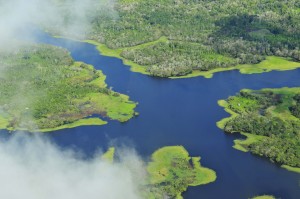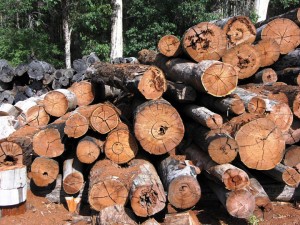Sustainability transcends disciplines, and the question of how to protect natural resources from pillaging by profit-hungry corporations and governments alike spans technological, economic, and political fields. Efficiency measures and water filters have their place, but key to implementing any measure is an analysis of where action is required, who needs it, and how it is to be fulfilled.
Currently, such cost-benefit analysis is alarmingly one-sided. The cost of a water purification station built on the Quinnipiac River can be estimated. The benefits, however, are ethereal, and attempts to reflect these benefits in dollar values that policy-makers best understand miss much of their true value. Emerging methodologies for natural resource pricing promise future cost-benefit analyses that account for current externalities, providing the hope for a more systematically sustainable future.
Researchers responding to the call for new methods are forging new collaborations in search of unique approaches to the problem. Yale’s own Eli Fenichel, assistant professor in the Yale School of Forestry & Environmental Science, is one such researcher. In his paper, “Measuring the value of groundwater and other forms of natural capital,” he works to craft an interdisciplinary approach to evaluating nature’s price. The research team specifically examined Kansas’ High Plains Aquifer and constructed a model of pricing the groundwater. The aquifer supports billions of dollars in agricultural revenue, and the group’s results warned of losses in groundwater value unaddressed by policy makers. Groundwater supports 40 percent of the world’s food production, but is a resource past researchers have struggled to value. In fact, the 2014 UN Inclusive Wealth Report specifically targets groundwater valuation as an area of necessary improvement. Ultimately, accurate valuation of natural resources allows for their inclusion within cost-benefit scenarios through economic comparison.
Markets and resources
Resources are most easily valued by the products extracted from them. It is far simpler to assign a price tag to a mango tree based on the value of mangos sold than to calculate its effect on adjacent crops or take into account its anti-erosion value. Yet, the assignment of value to natural resources based purely on productive results fails to ensure long-term success.

A four-decade-old National Bureau of Economic Research report describes the gap between economic and environmental accounting, claiming that the conventional final product-based approach “gives incorrect indications of changes in welfare…because it fails to allow for the disamenities associated with industrial growth, particularly pollution of air and water.” The old call for new methodology has become increasingly urgent, as modern institutions need better evaluative measures to quantify the plethora of sustainability measures taking root across the world.
World organizations and a call for progress
In particular, the World Bank has criticized GDP’s role as the foremost index of national economic success. Instead, it has sought to implement new forms of wealth accounting that takes into consideration natural resource holdings. National Capital Accounting (NCA) credits long-term development of a portfolio of assets beyond just industrial products, including natural, human, and social capital. NCA has risen in public awareness, most notably when the UN adopted it with its Statistical Commission of the System for Environmental and Economic Accounts in 2012 for application to extraction-intensive industries like minerals, timber, and fisheries.
However, the methodology of NCA is far from set, and one of the key goals of the World Bank’s NCA project was to develop an accurate ecosystem accounting methodology while building support for its use. NCA can provide a common language for sustainability measures between policy makers, scientists, and economists by placing everything in the same units — in this case, dollars.
Groundwater as capital
Professor Eli Fenichel’s groundwater study sought just that: an accurate price on groundwater that takes into account its natural impacts. Erin Haacker, a geologist at Michigan State, had done previous research on the Kansas High Plains Aquifer, and contributed technical expertise to the research that ultimately yielded groundbreaking results.
Groundwater contributes value to ecosystems in a myriad of ways, from natural purification to soil stabilization to agricultural watering. The National Research Council describes groundwater’s value as “determined jointly by the interaction of geologic/hydrologic factors and economic factors,” and an analysis of these factors revealed a potential crisis in the making.
To begin valuing the groundwater, the water first had to be quantified. The team defined the stock of groundwater as a measure of rock saturation by aquifer volume, and looked for volume changes over a ten-year period under one surface acre. Over the time period, they found that the water under an average acre fell by about a foot, or by two-fifths of a percent annually. Then, they used NCA to estimate the value of that lost groundwater.

The research team estimated through their model that Kansas lost $110 million of groundwater value over a ten-year period. Given the importance of data in driving policy decisions related to investment, Fenichel called for a portfolio management decision-making process that included such natural capital losses alongside agricultural gains so that policy makers had the data to evaluate future measures. “A lack of data is an increasingly poor excuse for not taking externalities into account,” Fenichel said, using the economic term for costs not taken into account by the market system. The natural and social sciences often struggle to overlap in scope, but mathematics can serve to connect them. “Mathematics [is] the language of interdisciplinary research,” Fenichel said. He argued that quantitative models can bridge gaps between fields to better describe important systems.
Paths forward
The results of Fenichel’s research lend weight to calls such as the World Bank’s for wealth accounting that includes natural resources. Renowned environmental economist Pavan Sukhdev argues that putting a price on natural resources makes states aware of their ecological resources, and that decision-makers currently lack the weighing measures to make good decisions. “Economics is mere weaponry,” Sukhdev said in a recent post.
The UN is particularly eager to apply better models to decisions over competing land uses, and NCA has immense promise for developing and developed countries alike. Countries have incentive to apply accurate cost-benefit analysis to counteract possible resource depletion, and Fenichel argued that Kansas should offset losses in groundwater with equal investments, whether in water storage, education, or a myriad of other options. Developing countries, however, often struggle to make decisions over land use in areas rich in biodiversity, such as decisions over hydropower. NCA can better quantify decisions to maximize economic growth while minimizing tradeoffs such as flood protection and other ecosystem services. In the case of the Kansas High Plains Aquifer, the research done by Fenichel and his colleagues provides data for lawmakers to pursue sustainable alternative investments as necessary for their continued wellbeing, instead of an expensive and unrelated consideration.
Ecosystems are incredibly complex scientific systems. Politics are amazingly difficult to navigate. Economics is frustratingly imprecise. The combination of the three presents extreme difficulty, but to protect natural systems, models to bring factors into the same units are essential to beneficial decisions. Natural capital accounting and other attempts to price natural resources formerly outside of market systems offer the promise of including previously unseen consequences into the discussion as momentum builds for environmental protection.
Extra Reading:
Fenichel, Abbott, Bayham, Boone, Haacker, and Pfeiffer. “Measuring the value of groundwater and other forms of natural capital.” Proceedings of the National Academy of Sciences of the United States of America. Vol. 113 No. 9 (Dec 2015).
About the Author:
Kathryn Ward is a sophomore Applied Mathematics major in Timothy Dwight College fascinated by the interplay between technology, economics, and politics in the rapidly evolving energy industry. She writes additionally for the Yale Globalist, serves as the editor-in-chief of the Yale Pawprint, is a Yale Energy Club board member, and leads School of Engineering tours.
Acknowledgements:
The author would like to thank Professor Fenichel for taking the time to interview.
Cover Image: Kansas wheat depends on extensive water extraction from the High Plains Reservoir, which had a net ground water loss of 110 million USD according to Professor Fenichel’s study. Image courtesy of Wikimedia Commons

